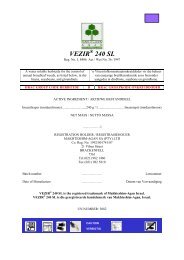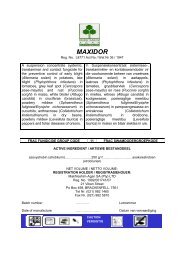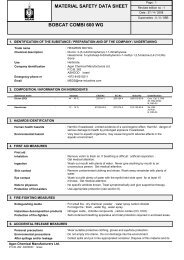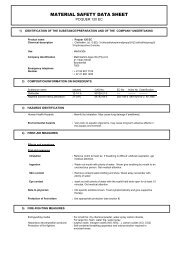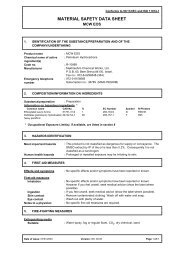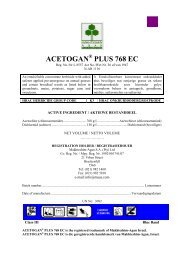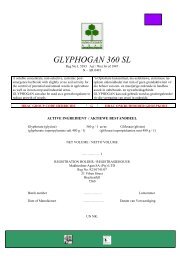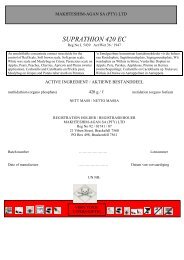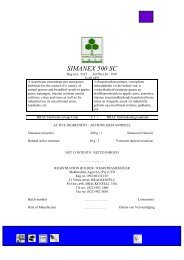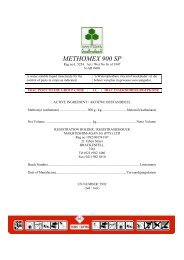BROMOTRIL T - Makhteshim-Agan
BROMOTRIL T - Makhteshim-Agan
BROMOTRIL T - Makhteshim-Agan
You also want an ePaper? Increase the reach of your titles
YUMPU automatically turns print PDFs into web optimized ePapers that Google loves.
A selective suspension concentrate herbicide<br />
for the post-emergence control of certain<br />
broadleaf weeds in maize, grain sorghum,<br />
sugarcane, sweetcorn and fodder sorghum.<br />
<strong>BROMOTRIL</strong> T<br />
Reg.No. L6653 Act / Wet 36/1947<br />
N-AR 0870<br />
‘n Selektiewe na-opkom suspensie<br />
konsentraat onkruiddoder vir die beheer van<br />
sekere breëblaaronkruide in mielies,<br />
graansorghum, suikerriet, suikermielies en<br />
voersorghum.<br />
ACTIVE INGREDIENTS / AKTIEWE BESTANDDELE<br />
Bromoxynil (Nitrile)…………………150 g / l………………..Bromoksinil (Nitriel)<br />
(Heptanoate and octanoate esters) (Heptanoaat en oktanoaat esters)<br />
Terbuthylazine (Triazine)…………….333 g / l……………….Terbutilasien (Triasien)<br />
NETT CONTENTS……………………………………………….NETTO INHOUD<br />
REGISTRATION HOLDER / REGISTRASIEHOUER:<br />
MAKHTESHIM – AGAN SA (PTY) LTD<br />
Reg No. 1992 / 001741 / 07<br />
21 Viben Street<br />
BRACKENFELL<br />
7560<br />
Tel No (021) 982 1460<br />
Batch number………………………………………………………………Lotnommer<br />
Date of Manufacture………………………………………..Datum van Vervaardiging<br />
HARMFULL<br />
SKADELIK
WARNINGS<br />
A minimum of 14 days should be allowed between application and grazing or feeding:<br />
- Handle with care<br />
- Poisonous if swallowed, inhaled or absorbed through the skin.<br />
- Irritating to eyes and may cause sensitisation by skin contact.<br />
- Toxic to fish, bees and wildlife.<br />
- Store in a cool, dry place away from food and feedstuffs.<br />
- Keep out of reach of children, uninformed persons and animals.<br />
- May cause harm to the unborn child.<br />
Aerial application:<br />
Aerial application of <strong>BROMOTRIL</strong> T may only be done by a registered Aerial Application<br />
Operator using a correctly calibrated, registered aircraft according to the instructions of SABS<br />
Code 0118 (Aerial Application of Agricultural Pesticides). Ensure that the spray mixture is<br />
distributed evenly over the target area and that the loss of spray material during application is<br />
restricted to a minimum. It is therefore essential that the following criteria be met:<br />
• Volume: A spray mixture volume of 30 (at least) to 35 (recommended) litres per hectare<br />
is recommended. As this product has not been evaluated at a reduced volume rate, the<br />
registration holder cannot guarantee efficacy, or be held responsible for any adverse<br />
effects if this product is applied aerially at a lower volume rate than recommended above.<br />
• Droplet coverage: 35 to 45 droplets per cm² must be recovered at the target area.<br />
• Droplet size: A droplet spectrum with a VMD of 350 microns is recommended. Limit<br />
the production of fine droplets less than 150 microns (high drift and evaporation<br />
potential) to a minimum.<br />
• Flying height: Maintain the height of the spray boom at 3 to 4 metres above the target.<br />
Do not spray when aircraft dives, is in a climb or when banking<br />
• Use suitable atomising equipment that will produce the desired droplet size and coverage,<br />
but which will ensure the minimum loss of product. The spraying system must produce a<br />
droplet spectrum with the lowest possible Relative Span.<br />
• Position all the atomisers within the inner 60 to 75 % of the wingspan to prevent droplets<br />
from entering the wingtip vortices.<br />
• The difference in temperature between the wet and dry bulb thermometers, of a whirling<br />
hygrometer, should not exceed 8°C.<br />
• Stop spraying if the wind speed exceeds 15 km/h.<br />
• Stop spraying under turbulent, unstable and dry conditions during the heat of the day.<br />
• Spraying under temperature inversion conditions (spraying in or above the inversion<br />
layer) and/or high humidity conditions (relative humidity 80 % and above) may lead to<br />
the following:<br />
a) reduced efficacy due to suspension and evaporation of small droplets in the air<br />
(inadequate coverage).<br />
b) damage to other sensitive crops and/or non-target areas through drifting of the<br />
suspended spray cloud away from the target field.<br />
• Ensure that the Aerial Spray Operator knows exactly which fields to spray.<br />
• Obtain an assurance from the Aerial Spray Operator that the above requirements will be<br />
met and that relevant data will be compiled in a logbook and kept for future reference.
Although this remedy has been extensively tested under a large variety of conditions the<br />
registration holder does not warrant that it will be efficacious under all conditions<br />
because the action and effect thereof may be affected by the factors such as abnormal<br />
climatic and storage conditions, the quality of dilution water, compatibility with other<br />
substances not indicated on the label and the occurrence of resistance of weeds against<br />
the remedy concerned as well as by the method time and accuracy of application. The<br />
registration holder further more does not accept responsibility for damage to crops,<br />
vegetation, the environment or harm to man or animal or lack of performance of the<br />
remedy concerned due to failure of the user to follow label instructions or to the<br />
occurrence of conditions which could not have been foreseen in terms of the registration.<br />
Consult the supplier in the event of any uncertainty.<br />
PRECAUTIONS<br />
- Avoid inhalation of fumes and spray mist.<br />
- Wear protective clothing, overalls, boots, and rubber gloves while mixing or applying<br />
the product.<br />
- Wash with soap and water after application.<br />
- Remove and wash contaminated clothing after a days work.<br />
- In case of eye contact wash out eyes with clean running water for at least 15 minutes.<br />
- Do not ear, drink or smoke whilst mixing or applying of before hands and face have<br />
been washed and clothes have been changed.<br />
- Avoid contamination of food, eating utensils, feed and drinking water.<br />
- Avoid drift of spray mist to other crops, grazing, rivers, dams or any other area that is<br />
not under treatment.<br />
- Do not mix and load within 15 m from boreholes, rivers, streams or dams.<br />
- Do not apply within 15 m from boreholes, rivers and streams.<br />
- Do not apply within 60 m from dams.<br />
- Clean applicator thoroughly after use. Dispose of wash water where it will not<br />
contaminate the environment.<br />
- Invert the empty container over the spray tank and allow to drain for a minimum of<br />
30 seconds after the flow has slowed down to a drip, thereafter rinse the container<br />
three times with a volume of water equal to at least 10% of that of the container. Add<br />
the rinsings to the contents of the spray tank. Dispose of the container by making<br />
holes in it, flattening it and burying it. Do not use the container for any other<br />
purpose.<br />
USE RESTRICTIONS<br />
To prevent damage to follow on crops, the following waiting periods after the application<br />
of <strong>BROMOTRIL</strong> T should be adhered to:<br />
Maize and Sugarcane None<br />
All other crops 4 Months<br />
EXCEPT<br />
Where the clay content of the soil is less than 20% the organic material content is<br />
less than 1,0% and the soil pH is more than 7 the waiting period for all other crops<br />
changes to 12 months.
DIRECTIONS FOR USE<br />
USE ONLY AS DIRECTED<br />
<strong>BROMOTRIL</strong>-T is compatible with Atrazine SC formulations and the mixture can be<br />
used if a longer residual action is needed on susceptible broadleaf weeds.<br />
MIXING INSTRUCTIONS<br />
SHAKE THE <strong>BROMOTRIL</strong>-T CONTAINER THOROUGHLY BEFORE USE.<br />
REPLACE AND TIGHTEN THE CAP AFTER USE.<br />
Half fill the spray tank with clean water. Mix the required volume of <strong>BROMOTRIL</strong>-T<br />
separately in water and add to the spray tank while agitating the spray mixture. Fill the<br />
spray tank with water while agitation is maintained. If <strong>BROMOTRIL</strong>-T is used in a tank<br />
mixture with Atrazine SC formulations the <strong>BROMOTRIL</strong>-T should be added first into the<br />
half filled spray tank and the Atrazine SC thereafter. Fill the tank with water while<br />
agitation is maintained. The spray mixture must be agitated continuously before and<br />
during application. The spray mixture should never be allowed to stand overnight.<br />
APPLICATION<br />
To achieve effective weed control, thorough wetting of the target weeds is essential.<br />
GROUND APPLICATION<br />
A tractor mounted sprayer filled with a conventional boom and flat nozzles can be used<br />
for the application of <strong>BROMOTRIL</strong>-T. The pressure during spraying should not exceed<br />
300 kPa. To ensure thorough wetting of the target weeds at least 250-300 l water per ha<br />
should be used.<br />
If the crop is higher than 400 mm and the foliage is very dense, drop arms can be used to<br />
ensure thorough wetting of the target weeds.<br />
AERIAL APPLICATION<br />
<strong>BROMOTRIL</strong>-T van be applied aerially provided that the spray mixture is applied evenly<br />
over the target area and that the loss of chemical is limited to the minimum during<br />
application. To achieve this, the following conditions must be met:<br />
- A conventional spray boom fitted with flat fan nozzles eg. SS 6515 or similar should<br />
be used.<br />
- A minimum spray volume of 30 l but preferably 35 l per ha must be applied.<br />
- A minimum of 30-50 droplets per square centimetre should be recovered on the target<br />
area.<br />
- The droplet spectrum must have a VMD of 350 micron.<br />
- Maintain an altitude of 3 m above the target area at wind speeds of 0-8 km/h and 2 m<br />
above the target area at wind speeds of 8-15 km/h. Stop spraying when wind speed<br />
exceeds 15 km/h.<br />
- The difference between the readings of the wet and dry bulbs as determined by a<br />
whirling hygrometer should not exceed 8°C<br />
- Do not spray during the heat of the day.
It is essential to get assurance of the spray operator that the above mentioned conditions will<br />
be met.<br />
APPLICATION RATES<br />
CROP DOSAGE RATE per ha REMARKS<br />
MAIZE AND GRAIN<br />
SORGHUM<br />
SWEETCORN AND FODDER<br />
SORGHUM<br />
SUGARCANE (Plant and<br />
ratoon cane)<br />
Ground application:<br />
1,25 l<br />
Aerial application<br />
1,5 l<br />
Ground application:<br />
1,5 l<br />
Aerial application:<br />
1,8 l<br />
Ground application:<br />
1,25 l <strong>BROMOTRIL</strong>-T +<br />
1,0-2,0 l Atrazine SC<br />
Aerial application:<br />
1,5 l <strong>BROMOTRIL</strong>-T +<br />
1,0-2,0 l Atrazine SC<br />
Ground application:<br />
1,5 l <strong>BROMOTRIL</strong>-T +<br />
1,0-2,0 l Atrazine SC<br />
Ground application:<br />
1,25 l<br />
Ground application:<br />
1,5 l<br />
Ground application:<br />
2,0 l<br />
Apply post-emergence when most of the weeds<br />
have germinated but before they have developed<br />
beyond the 4-leaf stage except if stated otherwise<br />
on the lists below.<br />
Apply post-emergence when most of the weeds<br />
have germinated but before they have developed<br />
beyond the 6-leaf stage except if stated otherwise<br />
on the lists below.<br />
If longer residual action is needed, tank mixes with<br />
Atrazine SC can be made as follows:<br />
Apply post-emergence when most of the weeds<br />
have germinated but before they have developed<br />
beyond the 4-leaf stage, except if stated otherwise<br />
on the lists below.<br />
Apply post-emergence when most of the weeds<br />
have germinated but before they have developed<br />
beyond the 6-leaf stage, except if stated otherwise<br />
on the lists below.<br />
Apply post-emergence when most of the weeds<br />
have germinated, but before they have developed<br />
beyond the 4-leaf stage, except if stated otherwise<br />
on the lists below.<br />
Apply post-emergence when most of the weeds<br />
have germinated, but before they have developed<br />
beyond the 6-leaf stage, except if stated otherwise<br />
on the lists below.<br />
Apply post-emergence when most of the weeds<br />
have germinated but before they have developed<br />
beyond the 6-leaf stage, except if stated otherwise<br />
on the lists below.
IMPORTANT INFORMATION<br />
1. If the crop is subjected to stress conditions eg. High temperatures, drought, low<br />
temperatures, nutrient deficiencies, insect or nematode damage, etc. during or shortly<br />
after the application of <strong>BROMOTRIL</strong>-T, chlorosis or leaf scorch might appear on the<br />
crop. Crop plants usually recover completely with no detrimental effect on yield.<br />
If maize plants are subjected to streak disease serious damage might occur<br />
after a <strong>BROMOTRIL</strong>-T application.<br />
2. If weeds have developed beyond the growth stage as indicated on the label at<br />
application of <strong>BROMOTRIL</strong>-T, poor weed control may result.<br />
3. To obtain optimum weed control, weeds should be growing actively at the time of<br />
application. Any stress condition will be detrimental to weed control.<br />
4. Thorough wetting of weeds should be ensured to obtain good weed control. Drop<br />
arms can be used if the crop is too high of foliage growth is too dense to ensure<br />
thorough wetting.<br />
5. <strong>BROMOTRIL</strong>-T controls susceptible annual broad leaf weeds only. To control<br />
annual grasses a suitable pre-emergence grass herbicide should be used.<br />
6. When Atrazine SC is used in a tank mix with <strong>BROMOTRIL</strong>-T, the Atrazine SC<br />
label should be studied carefully and not should also be taken regarding the waiting<br />
periods.<br />
7. No adjuvants must be used with <strong>BROMOTRIL</strong>-T as they van cause damage to the<br />
crop or even be detrimental on the effectivity.<br />
8. Do not mix <strong>BROMOTRIL</strong>-T with any other compound, except Atrazine SC, before<br />
the supplier has been consulted.
WAARSKUWINGS<br />
‘n Minimum periode van 14 dae moet toegelaat word tussen toediening en beweiding of voer.<br />
- Hanteer versigtig.<br />
- Giftig indien ingesluk, ingeasem of deur die vel geabsorbeer word.<br />
- Irreterend vir oë en mag sensitisering deur velkontak veroorsaak.<br />
- Giftig vir visse, bye en die natuurlewe.<br />
- Berg in ‘n koel plek, weg van voedsel en voer.<br />
- Hou buite bereikvan kinders, oningeligtre persone en diere.<br />
- Moontlike risiko dat dit skadelik kan wees teenoor ‘n ongebore kind.<br />
Alhoewel hierdie middel omvattend onder ‘n groot verskeidenheid toestande getoets is,<br />
waarborg die registratiehouer nie dat dit onder alle toestande doeltreffend sal wees nie,<br />
aangesien die werking en effek daarvan beivloed kan word deur faktore soos abnormale<br />
klimats- en bergingstoestande, kwaliteit van verdunningswater, verenigbaarheid met<br />
ander stowwe wat nie op die etiket aangedui is nie en die voorkoms van weerstand van<br />
die onkruid teen die betrokke middel sowel as die metode, tyd en akkuraatheid van<br />
toediening. Verder aanvaar die registrasiehouer nie verantwoordelikeheid vir skade<br />
aan gewasse, plantegroei, die omgewing of vir die nadelige effek op mens en dier of vir<br />
‘n gebrek aan prestasie van die betrokke middel as gevolg van die versuim van die<br />
gebruiker om etiketaanwysings na te kom of as gevolg van die ontstaan van toestande<br />
wat nie kratens die registrasie voorsien kon word n ie. Raadpleeg die verskaffer in die<br />
geval van enige onsekerheid.<br />
VOORSORGMAATREëLS<br />
- Moet nie dampe of sproeinewel inasem nie.<br />
- Dra beskermende oorklere ( oorpak, stewels en rubberhandskoene) wanneer die<br />
produk vermeng of toegedien word. Was met water en seep na toediening.<br />
- Trek besoedelde klere uit en was daagliks.<br />
- In die geval van oogkontak spoel met lopende water uit vir ten minste 15 minute.<br />
- Moet nie eet, drink of rook tydens vermening of toediening of voordat hande en<br />
gesig gewas is en skoon klere aangetrek is nie.<br />
- Verhoed die besoedeling van voedsel, eetgerei, voer en drinkwater.<br />
- Moet nie meng en laai nader as 15 m vanaf boorgate, riviere, strome en damme<br />
nie.<br />
- Moet nie nader as 15 m vanaf boorgate, riviere, en strome toedien nie.<br />
- Moet nie nader as 60 m vanaf damme toedien nie.<br />
- Dra sorg dat geen terugsyfering deur besproeiingstelsels na boorgate en damme<br />
plaasvind nie.<br />
- Maak die spuittoerusting deeglik skoon na toediening en gooi die waswater weg<br />
war dit nie die omgewing kan besoedel nie.<br />
- Keer leë houer om oor die spuittenk en dreineer vir tenminste 30 sekondes nadat<br />
die vloei tot ‘n gedrup verminder het. Spoel daarna die houer drie keer uit met ‘n<br />
volume water wat gelykstaande aan minstens 10% van die volume van die leë<br />
houer is. Gooi die spoelwater by die inhoud van die spuittenk. Vernietig die leë<br />
houer deur gate daarin te maak, plat te druk en dit te begrawe.<br />
- Moet leë houer vir geen ander doel gebruik nie.<br />
GEBRUIKSBEPERKINGS<br />
Om skade aan gevoelige opvolggewasse te beperk, moet die volgende wagperiodes na<br />
toediening van <strong>BROMOTRIL</strong>-T gehandhaaf word:
Mielies en Suikerriet Geen<br />
Alle ander gewasse 4 Maande<br />
BEHALWE<br />
Waar die klei-inhoud van die grond minder as 20% is, oganiese materiaalinhoud<br />
minder as 1% is en die pH van die grond meer as 7, is verander die wagperiode vir<br />
alle gevoelige gewasse na 12 maande.<br />
GEBRUIKSAANWYSINGS<br />
GEBRUK SLEGS SOOS AANGEDUI<br />
VERENIGBAARHEID<br />
<strong>BROMOTRIL</strong>-T is verenigbaar met Atrasien SC formulasies en die mengsel kan gebruik<br />
word om langer nawerking op gevoelige breëblaaronkruide te bewerkstellig.<br />
VERMENING<br />
SKUD DIE KAN DEEGLIK VOOR GEBRUIK. DRAAI DIE SKROEFPROP VAS NA<br />
GEBRUIK.<br />
Vul die spuittenk half vol met skoon water. Vermeng die benodigde hoevelheid<br />
<strong>BROMOTRIL</strong>-T apart in water en voeg in spuittenk terwyl gedurigdeur geroer word.<br />
Vul die spuittenk tot op die verlangde volume met water terwyl geroer word.<br />
Indien <strong>BROMOTRIL</strong>-T met ‘n Atrasien SC formulasie in ‘n tenkmengsel gebruik word<br />
moet die <strong>BROMOTRIL</strong>-T eerste in die halfvol spuittenk gevoeg word terwyl geroer<br />
word. Die Atrasien SC formulasie word daarna in die spuittenk gevoeg terwyl geroer<br />
word. Die oorlywende volume water word dan in die spuitenk gevoeg.<br />
Die spuitmengsel moet voor en tydens toediening gedurigdeur geroer word. Die<br />
spuitmengsel moet nie oornag laat staan word nie.<br />
TOEDIENING<br />
‘n Deeglike benatting van onkruide is noodsaaklik vir doeltreffende beheer.<br />
GRONDTOEDIENING<br />
‘n Trekkerspuit toegerus met ‘n konvensionele spuitbalk en plat waaierspuitpunte, kan vir<br />
die toediening van <strong>BROMOTRIL</strong>-T gebruik word. Die spuitdruk moet nie 300 kPa<br />
oorskry nie. Om deeglike benatting van die onkruide te verkry moet minstens 250-300 l<br />
water per ha gebruik word.<br />
Indien die gewas hoër as 400 mm is en ruig groei, kan van valarms gebruik gemaak word<br />
om ‘n deeglike bedekking van onkruid te verkry.<br />
Lugtoediening:<br />
<strong>BROMOTRIL</strong> T kan slegs deur ‘n geregistreerde Lugbespuitingsperateur met ‘n korrek<br />
gekalibreerde, geregistreerde vliegtuig volgens die instruksies van SABS Kode 0118 (Aerial<br />
Application of Agricultural Pesticides) uit die lug bespuit word. Verseker dat die<br />
spuitmengsel eweredig oor die teikenarea versprei word, en die verlies aan spuitmengsel<br />
tydens toediening tot ‘n minimum beperk word. Dit is daarom belangrik om aan die volgende<br />
vereistes te voldoen:
• Volume: ‘n Spuitmengsel volume van 30 (minimum) tot 35 (aanbevole volume) liter<br />
per ha word aanbeveel. Hierdie produk is nie teen ‘n verlaagde volume getoets nie.<br />
Die registrasiehouer kan nie effektiteit waarborg, of verantwoordelik gehou word vir<br />
enige nadelige effekte indien hierdie produk teen ‘n laer volume, as hierbo aanbeveel,<br />
toegedien word nie.<br />
• Druppel bedekking: 35 tot 45 druppels per cm² moet op die teikenarea herwin word.<br />
• Druppelgrootte: ‘n Druppelspektrum met ‘n VMD van 350 mikrons word aanbeveel.<br />
Beperk die produksie van druppels kleiner as 150 mikrons (hoë drywing en<br />
verdampingspotensiaal) tot ‘n minimum.<br />
• Vlieghoogte: Handhaaf die hoogte van die spuitbalk bo die teiken op 3 tot 4 meter.<br />
Moet nie spuit wanneer die vliegtuig duik nie, uitklim of draai nie.<br />
• Gebruik geskikte atomiseringsapparaat wat die vereiste druppelgrootte en bedekking<br />
sal produseer, maar die minste verlies van produk verseker. Die spuitstelsel moet ‘n<br />
druppelspektrum met die kleinste moontlike Relatiewe Span produseer.<br />
• Plaas al die atomiseerders in die binnste 60 tot 75 % van die vlerkspan om te verhoed<br />
dat druppels binne-in die vlerkpuntvorteks beweeg.<br />
• Die verskil in temperatuur tussen die nat- en droëboltermometer van ‘n<br />
swaaihigrometer, moet nie 8°C oorskry nie.<br />
• Stop bespuiting indien die windspoed 15 km/h oorskry.<br />
• Stop bespuiting tydens turbulente, onstabiele en droë toestande gedurende die hitte<br />
van die dag.<br />
• Bespuiting onder temperatuur inversie toestande (deur bo of binne die inversie laag te<br />
spuit) en/of hoë lugvog toestande (relatiewe humiditeit 80% en meer) mag tot<br />
volgende probleme aanleiding gee:<br />
a) verlaagde effektiwiteit aangesien die druppels as ‘n wolk in die lug bly hang en<br />
moontlik verdamp (onvoldoende bedekking op teiken).<br />
b) skade aan nie-teiken gewasse of sensitiewe areas as gevolg van wegdrywing van die<br />
spuitwolk na nie-teiken area.<br />
• Verseker dat die Lugbespuitingsoperateur presies weet watter lande bespuit moet<br />
word.<br />
• Dit is noodsaaklik om ‘n versekering van die Lugbespuitingsoperateur te verkry dat<br />
aan al die bogenoemde vereistes voldoen sal word en dat data van belang in ‘n<br />
logboek saamgevat is vir toekomstige verwysing.
TOEDIENINGSHOEVEELHEDE<br />
GEWAS TOEDIENGS-<br />
HOEVEELHEID per ha<br />
MIELIES EN<br />
GRAANSORGHUM<br />
SUIKERMIELIES EN<br />
VOERSORGHUM<br />
SUIKERRIET (Plant en<br />
oorstaan riet)<br />
Grondtoediening:<br />
1,25 l<br />
Lugtoediening:<br />
1,5 l<br />
Grondtoediening:<br />
1,5 l<br />
Lugtoediening:<br />
1,8 l<br />
Grondtoediening:<br />
1,25 l <strong>BROMOTRIL</strong>-T +<br />
1,0-2,0 l Atrasien SC<br />
Lugtoediening:<br />
1,5 l <strong>BROMOTRIL</strong>-T +<br />
1,0-2,0 l Atrasien SC<br />
Grondtoediening:<br />
1,5 l <strong>BROMOTRIL</strong>-T +<br />
1,0-2,0 l Atrasien SC<br />
Lugtoediening:<br />
1,8 l <strong>BROMOTRIL</strong>-T +<br />
1,0-2,0 l Atrasien SC.<br />
Grondtoediening:<br />
1,25 l<br />
Grondtoediening:<br />
1,5 l<br />
Grondtoediening:<br />
2,0 l<br />
BELANGRIKE INLIGTING<br />
OPMERKINGS<br />
Dien na-opkom toe wanneer die meeste onkruide<br />
alreeds opgekom het, maar nog nie verder<br />
gevorderd is as die 4-blaarstadium nie, behalwe<br />
as anders vermeld in die onderstaande tabelle.<br />
Dien na-opkom toe wanneer die meeste onkruide<br />
alreeds opgekom het, maar nog nie verder<br />
gevorderd is as die 6-blaarstadium nie, behlawe<br />
as anders vermeld word in onderstaande tabelle.<br />
Indien langer nawerking verlang word, kan die<br />
volgende tenkmengsels met Atrasien SC<br />
toegedien word:<br />
Dien na-opkom toe wanneer die meeste onkruide<br />
alreeds opgekom het maar nog nie verder<br />
gevorder is as die 4-blaarstadium nie, behalwe as<br />
anders vermeld word in die onderstaande tabelle.<br />
Dien na-opkom toe wanneer die meeste onkruide<br />
alreeds opgekom het maar nog nie verder<br />
gevorder het as die 6-blaarstadium<br />
nie, behalwe as anders vermeld in die<br />
onderstaande tabelle.<br />
Dien na-opkom toe wanneer die meeste onkruide<br />
alreeds opgekom het maar nog nie verder<br />
gevorder het as die 4-blaarstadium<br />
nie, behalwe as anders vermeld in die<br />
onderstaande tabelle.<br />
Dien na-opkom toe wanneer die meeste onkruide<br />
alreeds opgekom het maar nog nie verder<br />
gevorder het as die 6-blaarstadium<br />
nie, behalwe as anders vermeld in die<br />
onderstaande tabelle.<br />
Dien na-opkom toe wanneer die meeste onkruide<br />
alreeds opgekom het maar nog nie verder<br />
gevorder het as die 6-blaarstadium<br />
nie, behalwe as anders vermeld in die<br />
onderstaande tabelle.<br />
1. Indien die gewas aan stremming onderworpe is as gevolg van hoë temprature,<br />
droogte, koue, voedingstekorte, insek of aalwurmbesmetting ens. Mag vergeling
voorkom na toediening van <strong>BROMOTRIL</strong>-T. Normaalweg herstel die plante<br />
volledig en is daar geen invloed op die oesopbrengs nie.<br />
As mielies onderhewig is aan streepsiekte, mag ernstige skade voorkom.<br />
2. Indien onkruide verder ontwikkel het as wat gespesifiseer is, mag dit aanleiding<br />
gee tot swak onkruidbeheer.<br />
3. Onkruide moet aktief groei tydens die toediening van <strong>BROMOTRIL</strong>-T. Indien<br />
onkruid tydens toediening onder enige tipe stremming onderworpe is, mag dit tot<br />
swak beher van onkruid aanleiding gee.<br />
4. Deeglike benatting van die onkruid met <strong>BROMOTRIL</strong>-T moet verseker word.<br />
Indien die gewas te hoog en te ruig groei om deeglike benatting te verkry, kan<br />
van valarms gebruik gemaak word.<br />
5. <strong>BROMOTRIL</strong>-T beheer net gevoelige eenjarige breëblaaronkruide. Vir die<br />
beheer van eenjarige grasse moet van ‘n geskikte vooropkom grasdoder gebruik<br />
gemaak word.<br />
6. As <strong>BROMOTRIL</strong>-T saam met Atrasien SC in ‘n tenkmengsel toegedien word<br />
moet die instruksies op die Atrasien SC etiket noukeurig gelees word en moet<br />
daar ook aan die wag periodes van Atrasien SC voldoen word.<br />
7. Geen bevorderingsmiddel moet saam met <strong>BROMOTRIL</strong>-T gebruik word nie<br />
aangesien dit skade aan die gewas kan veroorsaak of selfs die effektiwiteit<br />
daarvan kan benadeel.<br />
8. Moet nie <strong>BROMOTRIL</strong>-T met ander chemikalieë as Atrasien SC formulasies<br />
meng voordat die verskaffer nie eers geraadpleeg is nie.
ONKRUIDE WAT DEUR <strong>BROMOTRIL</strong>-T BEHEER WORD INDIEN TOEDIENING<br />
TUSSEN DIE 4-6 BLAARSTADIUM VAN DIE ONKRUIDE TEEN DIE<br />
AANBEVOLE TOEDIENINGSHOEVEELHEDE PLAASVIND.<br />
WEEDS CONTROLLED BY <strong>BROMOTRIL</strong>-T WHEN APPLIED AT THE 4-6 LEAF<br />
STAGE OF THE WEEDS AT THE DOSAGE RATES AS RECOMMENDED.<br />
ONKRUIDE / WEEDS ALGEMENE NAAM COMMON NAME<br />
Acanthospernum hispidum Regopsterklits Upright starbur<br />
Alternanthera pungens Kakiedubbeltjie Paperthorn<br />
Amaranthus hybridus Gewone misbredie Common pigweed<br />
Amaranthus spinosus Doringmisbredie Thorney pigweed<br />
Argemone mexicana Geelblombloudissel Yellow flowered Mexican poppy<br />
Bidens pilosa Gewone knapsekêrel Common blackjack<br />
Capsella bursa-pastoris Herderstassie Shepards purse<br />
Chenopodium album Withondebossie White goosefoot<br />
Chenopodium carrinatum Groenhondebossie Green goosefoot<br />
Citrullus lanatus Karkoer Wild watermelon<br />
Cleome gynandra Snotterbelletjie Spider-wisp<br />
Commelina benghalensis Wandelende jood Wandering jew<br />
Cosmos bipinnatus Kosmos Cosmos<br />
Cucumis myriocarpus Streepwildekomkommer Striped wild cucumber<br />
Fallopia convolvulus Slingerduisendknoop Climbing knotweed<br />
Flaveria bidentis Smeltersbossie Smelter’s bush<br />
Galingsoga parviflora Knopkruid Gallant soldier<br />
Hibiscus trionum Terblansbossie Bladderweed<br />
Ipomoea coscinosperma - -<br />
Ipomoea purperea Purperwinde Morning glory<br />
Phyaslis angulata Wilde-appelliefie Wild gooseberry<br />
Polygonum aviculare Voëduisendknoop Prostrate knotweed<br />
Raphanus rephanistrum Ramenas Wild radish<br />
Schkuhria pinnata Kleinkakaiebos Dwarf marigold<br />
Sesanum triphyllum Wildesesam Wild sesame<br />
Sida cordifolia Hartblaartaaiman Flannel weed<br />
Solanum nigrum Nastergal Nightshade<br />
Sonchus oleraceus Sydissel Sowthistle<br />
Tagetes minuta Langkakiebos Tall Khaki Weed<br />
Xanthium spinosum Boetebossie Spiny cocklebur<br />
Xanthium strumarium Kankerroos Cocklebur
ONKRUIDE WAT BEHEER WORD DEUR <strong>BROMOTRIL</strong>-T IN DIE<br />
GROEISTADIUMS SOOS HIERONDER AANGEDUI.<br />
WEEDS CONTROLLED BY <strong>BROMOTRIL</strong>-T AS INDICATED IN THE GROWTH<br />
STAGES UNDERNEATH AS INDICATED.<br />
Onkruid / Weed Algemene Naam Common name Dosis / Dosage<br />
1,25 l / ha (grond) 1,5 l / ha (Grond)<br />
1,5 l / ha (lug) 1,8 l / ha (lug)<br />
Amaranthus thunbergii Rooimisbredie Red Pigweed 4-blaar / leaf 6-blaar / leaf<br />
Cleome monophylla Rusperbossie Spindlepod - 3-blaar / leaf<br />
Crotalaris sphaerocarpa Mielie Crotalaria Wild lucerne - 50 mm hoog/high<br />
Datura ferox Grootstinkblaar Large thorn-apple 6-blaar / leaf 8-blaar / leaf<br />
Datura Stramonium Olieboom Common thornapple<br />
6-blaar / leaf 8-blaar / leaf<br />
Portulaca oleracea Porselein Purslane - 3-blaar / leaf<br />
Tribulis terrestris Dubbeltjie Common dubbetjie 50 mm deursnee / 100 mm deursnee/<br />
diameter<br />
diameter



